Since the time of childhood to adulthood, a woman’s body goes through many changes. On physical, emotional and mental level, a woman experiences considerable ups and downs and increased stress owing to personal and professional reasons. All these results in her health going for a toss. A woman, many a times also struggles through menstrual problems, gynaecological disorders, stress and much more.
Yoga is an ancient practice that has been benefiting people across the globe – irrespective of age and gender. The practice of Yoga is even more essential and beneficial for women to tackle all the different phases of her life. The practice of a few specific asanas for women will be extremely instrumental in bringing harmony between the mind, body and soul.
Yoga offers holistic healing properties which will help women to increase their strength, flexibility, balance, tone their body, reduce stress and anxiety and bring in more relaxation. These asanas will provide immense benefits of Yoga for women.
Here are 7 Yoga Asanas that every woman should practice:
1) Marjariasana – Bitilasana
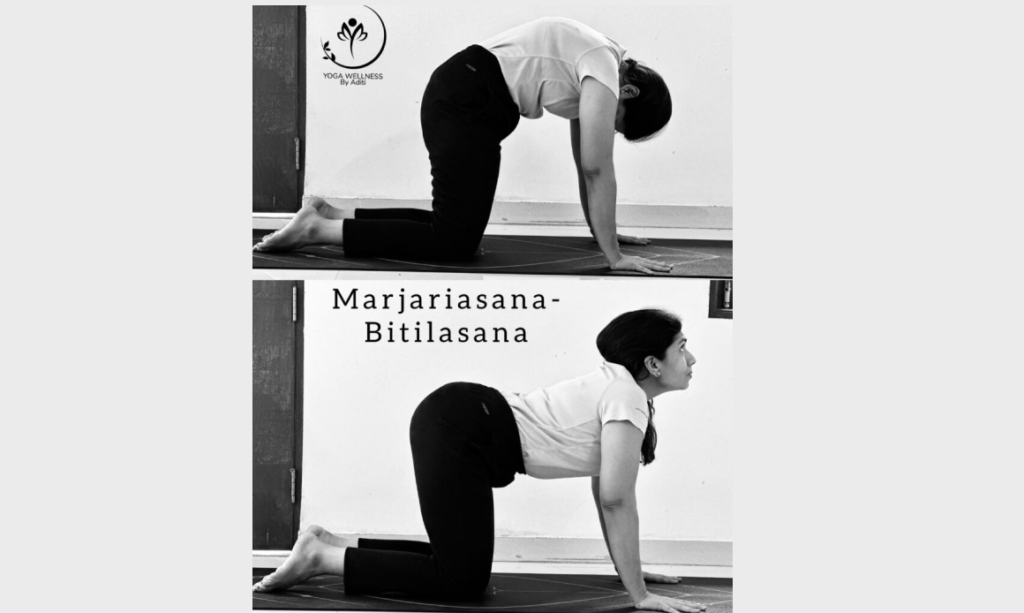
Marjariasana-Bitilasana is a combination of two asanas that comprise one of the most basic movements. In addition to easing the spinal tension, this asana-sequence calms the mind and relieves stress. Although simple, this asana requires precise body positioning for safety and maximum benefits. The knees should rest directly under the hips and the hands should be positioned directly under the shoulders. Any practitioner with neck or head pain should keep the neck and head in line with the body. For those with knee or wrist pain, the asana can be practiced while seated upright in a chair. This asana is believed to:
- It is effective for spine health as it stretches the backbone and strengthens it while also improving its flexibility.
- The asana strengthens the wrists.
- Marjariasana benefits the shoulders by making them stronger.
- The movements in the asana massage your digestive organs and activate them. As a result, the process of digestion is improved.
- It helps tone the abs by getting rid of excess fat from around the hips
- Since the asana requires to keep the body on four legs, it enhances blood circulation as well as oxygen flow through the body.
- The asana soothes the mind, thus helps to get rid of unnecessary stress and anxiety.
- The asana also aids in digestion and increased metabolism.
- This asana can soothe menstrual cramps and stiffness.
2) Bhadrasana
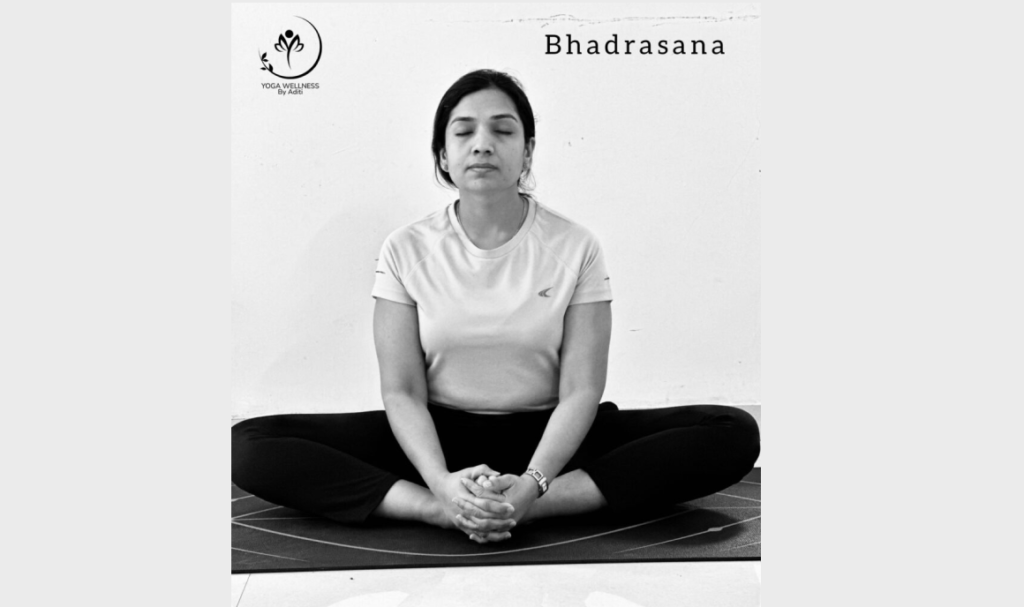
Bhadrasana or Gracious pose or Butterfly pose, as is commonly understood, is one of the many yoga poses suitable for the beginners. It is a great asana for meditation as it is comfortable and can be held for extended period of time. Practicing Bhadrasana calms the mind and brings about feeling of being grounded. If the practice of this asana seems difficult due to the stiffness in the pelvic, blankets, blocks and folded yoga mats can make great props for modified versions of this asana. The benefits of bhadrasana includes:
- The Bhadrasana is therapeutic for fatigue. if practiced regularly, it holistically energizes body, mind, and soul. It naturally rejuvenates the body and makes one feel fresh.
- As it is a meditative posture, it calms the brain. In this asana, the pranic energy is directed upwards that confers the practitioners with a healthy body and mind.
- Practice it regularly and gradually notice flexible legs. It holistically increases the pliancy of leg muscles along with hamstrings, quadriceps, thighs, and more.
- This asana promotes a healthy and strong spinal column. While in the asana, the spine is stretched which helps in restoring its natural curve and assists in alleviating backache.
- It is a natural and safe method for treating acidity, constipation, and several stomach problems. This asana is believed to enhance the digestive process of the practitioners.
- As it is a simple yoga asana, practitioners from different yoga levels can perform it with ease for attaining the spiritual rewards.
3) Adho Mukha Svanasana
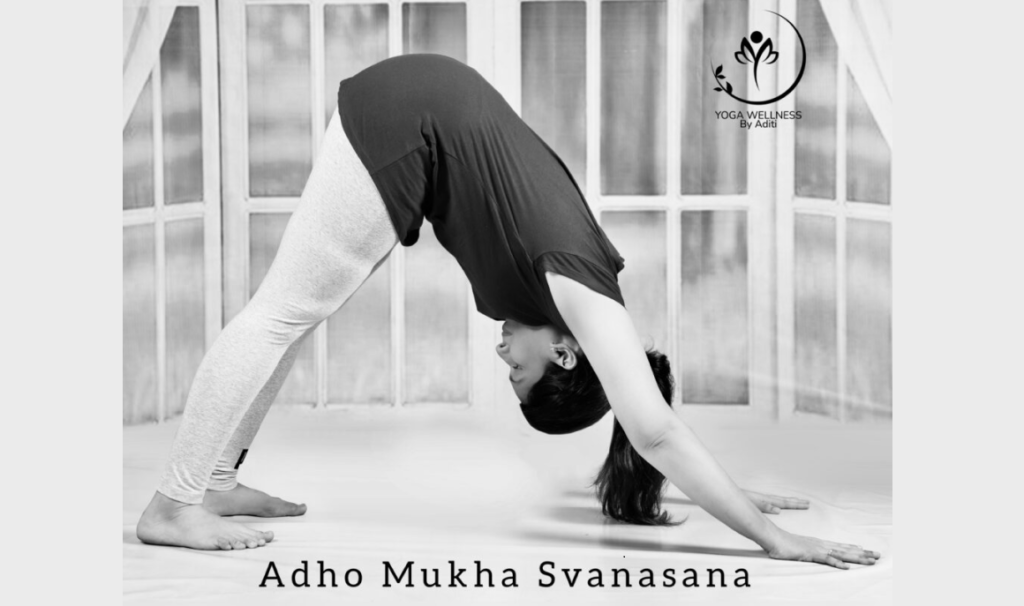
The name Adho Mukha Svanasana comes from Sanskrit where Adho means “down”, mukha means “face”, and “svana” means “dog”, and finally “asana” means “pose”.
Together Adho Mukha Svanasana is popularly called Downward Facing Dog pose. It is a foundational yoga asana which requires flexibility and upper body strength. In this asana, your body forms an inverted “V” with the feet and hands pressing into the ground and the hips raised upwards. It is performed in a sequence of asana as a part of the Surya Namaskar. This asana might seem to be easily attainable, however, it can get slightly difficult for the beginner practice. This asana requires to keep the core muscles engage throughout and so it can tone the lower abdominal region and helps in building the core muscles
- This asana requires to keep the core muscles engage throughout and so it can tone the lower abdominal region and helps in building the core muscles
- It strengthens the whole body – upper body, arms, shoulders, abdomen and legs.
- This asana stretches the back of the body, ankles, calves, hamstrings, and spine and thereby removes any stiffness or pain from these areas.
- It helps in calming down the mind.
- As this asana inverts the entire body, it results in stimulation of the blood circulation.
- Improves the balance and overall flexibility throughout the body.
- This asana works great to rest the spine while practicing Vinyasa or Power yoga sequences.
4) Setu Bandhasana
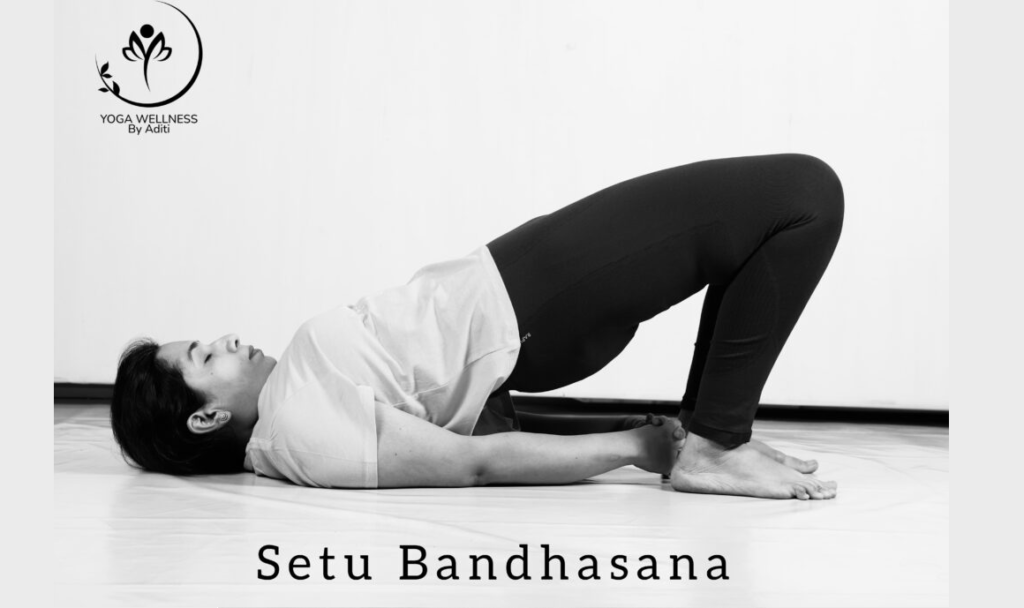
The word Setu Bandhasana is derived from the Sanskrit language where “Setu” means “Bridge”, “Bandha” means “Lock” or “Bind” and “Asana” means “Pose”. The pose is called Setu Bandhasana because when you perform it, your body looks like a bridge. Though it is an inverted back-bending asana, Setu Bandhasana is a great asana in yoga for beginners. It mainly targets spine, hamstrings, glutes, and hip flexors. This asana also helps in building and strengthening core and lower body, lengthens and strengthens the spine, energizes the body and stimulates the endocrine and nervous systems. This rejuvenating asana can also aid in calming the mind. However, a practitioner with recent or chronic injury of the knees, shoulders, or back should avoid doing the same.
- One of the best benefits of Setu Bandhasana is the incredible stretch it offers to your chest, neck, spine, and hips.
- This asana leads to the burning of fat in the abdominal area and tones the muscles.
- Setu Bandhasana also helps in calming your mind and alleviating symptoms of stress and depression.
- It stimulates your abdominal organs and lungs. This is also good asana to improve the functioning of the thyroid glands.
- It can also lower down the issues such as constipation and acidity.
5) Uttanasana
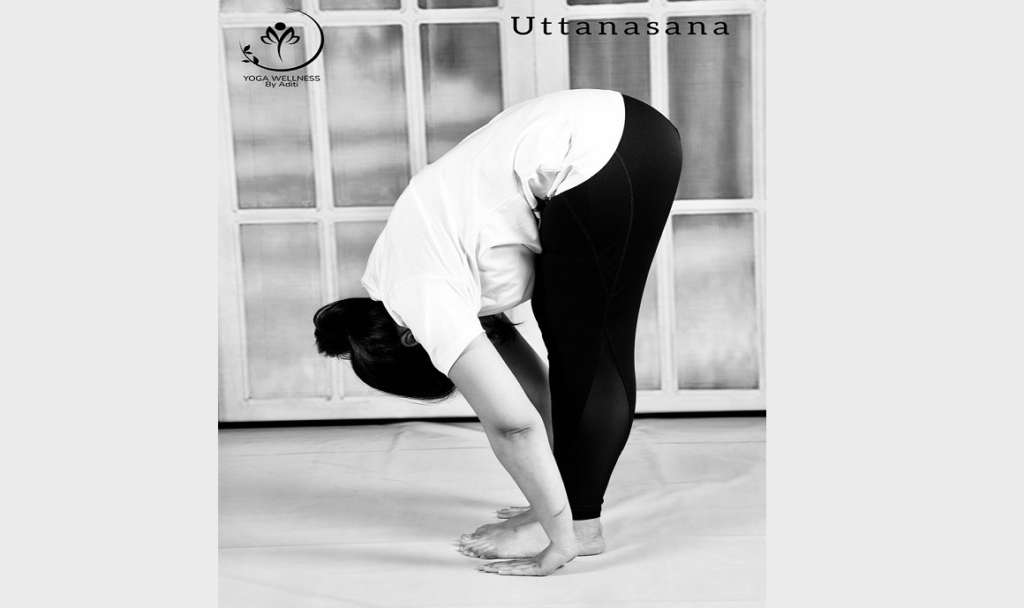
Uttanasana is an intense standing Hatha yoga asana that provides a deep stretch along the backside of the body, considered to be effective asana for relieving stress and soothing the nervous system. Uttanasana is considered an important asana because, in addition to the physical stretching and strengthening benefits, it is believed to be balancing the body. This is because of the combined elements of activity and passivity involved in this asana, while the body is folded. Like all forward bends, Uttanasana is believed to be calming the mind. It is a posture of surrender and, as such, may teach one patience and acceptance. Furthermore, the increased blood flow to the brain and the inverted nature of the posture, with the heart above the head, is said to relieve stress. This asana also forms part of the Surya Namaskar sequences. The important benefits of this asana include:
- This asana brings the stretch in the back of the legs, hips and spine.
- It strengthens the leg muscles, thighs and knees.
- It balances the nervous system and thereby calms the mind.
- As this asana involves pressing of the abdomen, it improves digestion, stimulates the liver and kidneys.
- Reducing stress, anxiety, depression, and fatigue.
- It aids in relieving tension in the lower back when practised with bent knees.
6) Bhujangasana
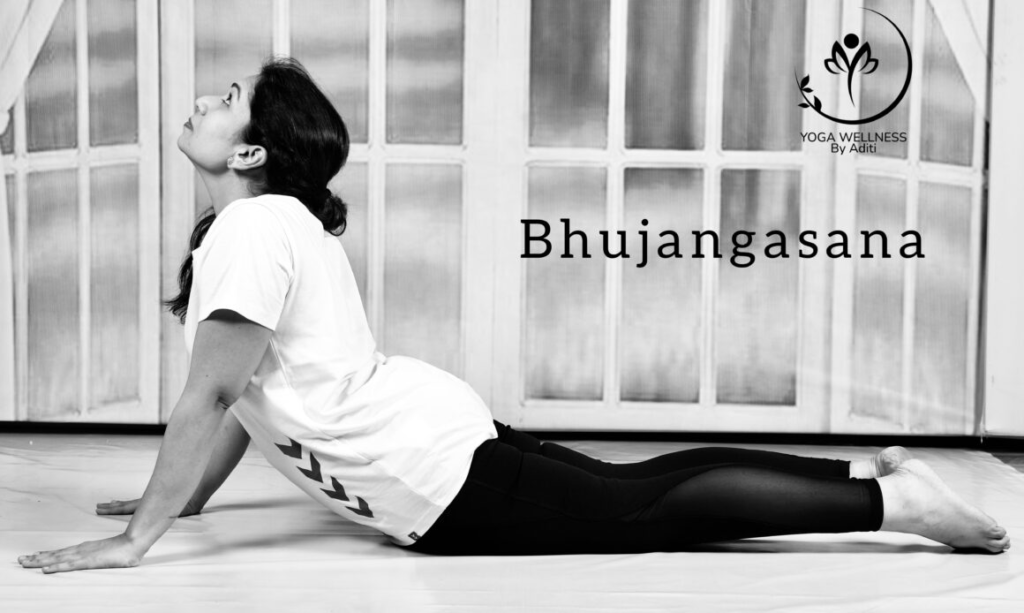
Bhujangasana is a back-bending asana in yoga that resembles a cobra with a raised hood. The Sanskrit term for “Bhujanga” is “snake” or “cobra” while ‘asana’ means the “pose”. It is also known as the ‘cobra pose’. This asana is a part of the Surya Namaskar as well. A regular practice of this asana aids in opening the chest and stretches the shoulders. It helps in increasing flexibility in your body and helps strengthens the core muscles. It is a great way to tone the abdominal muscles and helps in enhancing the lungs’ capacity. It aids in relieving fatigue and increases the energy levels. It is often practised as a transition to the Adho Mukha Svanasana in Vinyasa Yoga. This asana needs to be performed after a short warm-up or in sequential hatha yoga practice to avoid practice-related muscle injuries. Few of the many benefits includes:
- Bhujangasana strengthens the back muscles especially the lower back.
- It increases flexibility of the spine and the muscles around it.
- It tones the organs in the lower abdomen, the digestive organs, the urinary and reproductive organs.
- It tones the buttock muscles.
- Bhujangasana can correct some of the menstrual irregularities.
- This asana stimulates abdominal organs like the liver and kidney, stimulates appetite and alleviates constipation.
- Practicing this regularly soothes issues related to sciatica.
- It works as therapeutic for asthma, as it deepens breathing, while opening the chest muscles.
7) Pavanmuktasana
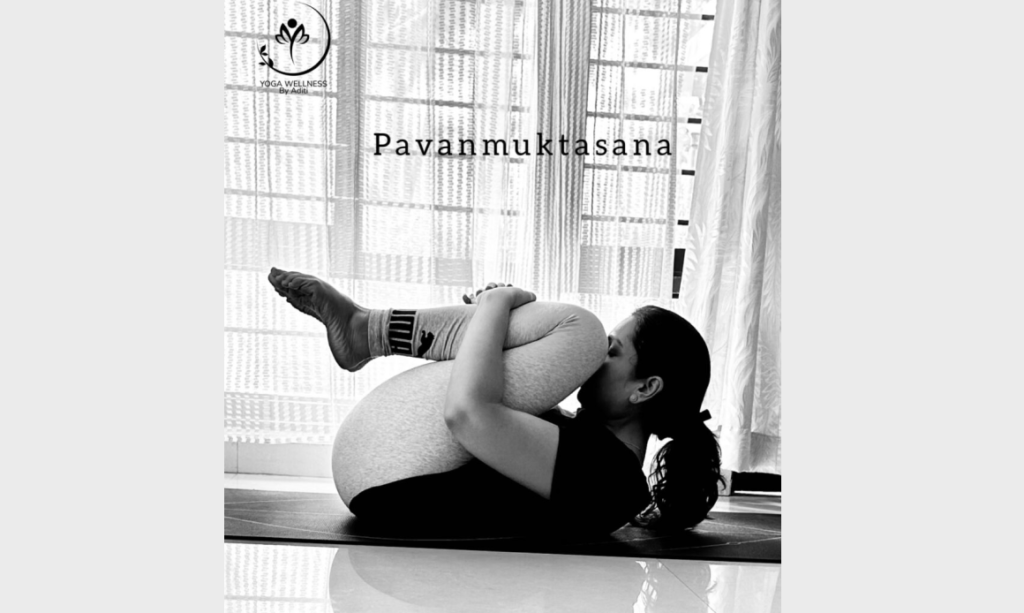
Pavanmuktasana is a reclined and a healing asana that is effective in helping release gas in the abdomen while massaging the entire back and spine. The name is derived from the Sanskrit, “pavana”, meaning “wind” “mukta:”, meaning “to release”; and “asana”, meaning “pose.” While lying on the back a practitioner bends both legs and hugs them into the body with the arms wrapped around the shins. At the same time, the chin tucks toward the chest. The head may rest on the ground or be lifted toward the knees. This asana can also be practiced in three segments by first hugging one leg at a time into the chest and then hugging both legs together. Few of the many benefits includes:
- Pavanmuktasana, if performed regularly strengthens the abdominal muscles and reduces belly fat.
- As the focus is on the abdominal region, it massages the intestines and other abdominal organs.
- This asana tones the arms, legs and buttocks and thereby aids in weight loss.
- This asana tones the arms, legs and buttocks and thereby aids in weight loss.
- The toning of the lower body and the strengthening of the lower back combined with hip stability enhances the body posture.
- This asana is good for conditions like constipation and irregular bowel syndrome and promotes digestion.
- A gradual effect of this asana will be felt by easing the tension, especially in the lower back and increased back strength.
- It enhances blood circulation in the hip joints.
- This asana removes the negative emotions and fears by positive stimulating the hip opening and balancing chakras.
Conclusion: To reap the optimal benefits of these asanas, it needs to be practiced regularly and if possible, under the guidance of a certified instructor. One needs to develop a positive mindset towards yoga to maintain consistency. Secondly, self – belief is essential to start a yoga journey. Practice these asanas on a daily basis and observe the changes in your body and mind. Taking into consideration the physical issues and limitations, one can begin to practice. From mental health issues to weight gain and spine problems, practicing these asanas will help you to tackle these problems in an effective manner. Remember, it all starts in your mind. Commit to consistency over perception in yoga. Everything else will fall in place.

Leave a Reply